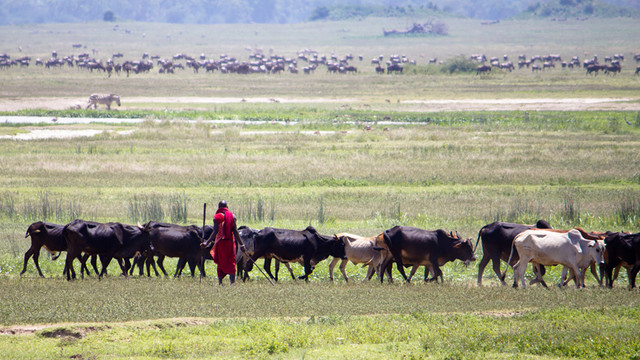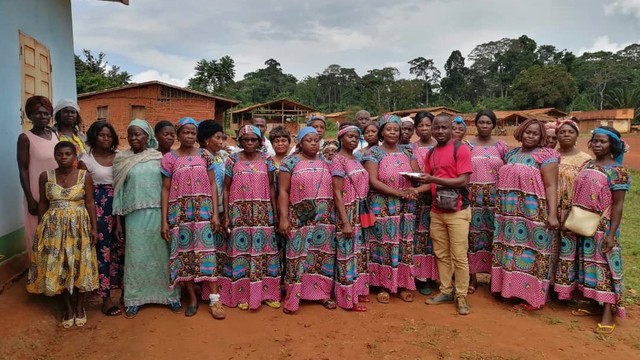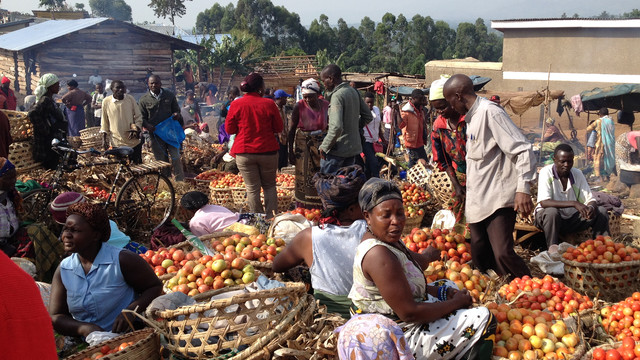Locally-led action for poverty, climate and nature – experiences from around the world
These case studies showcase where different approaches to locally led adaptation (LLA) have flourished around the world, providing examples of the eight principles of LLA in action.
The world faces a triple and interconnected crisis: a climate emergency, rapid biodiversity destruction and entrenched poverty. A range of actors globally are all working to demonstrate the importance of locally led action (LLA) for poverty, climate and nature in the face of this triple crisis.
The map above demonstrates an array of this work, showcasing the global spread of LLA practice.
The numerous delivery mechanisms show how LLA can be implemented in practice and show that alternative approaches to business-as-usual already exist, and that adaptation action should be supporting these types of locally-led initiatives.
Click on the following links to learn more about the specific experiences in each region:
LLA: what’s in the term?
Locally led adaptation as a term was launched under the Global Commission for Adaptation, but it had its roots in the wider framing of ‘Locally-led action for poverty, climate and nature’, which is why there is dual framing around LLA.
The work of IIED and partners is now moving to prioritise the use of the more holistic and encapsulating term ‘Locally-led action for poverty, climate and nature’.
The LLA principles
The core tenets of how locally-led action should be designed and implemented are summed up in the eight principles for LLA. These were launched at the January 2021 Climate Adaptation Summit in the Netherlands, and aim to guide stakeholders away from empty participation rhetoric towards ‘business-unusual’ adaptation financing, programming and policy.
Since the launch, the LLA movement has garnered strong momentum internationally, with growing awareness and support for the principles, particularly at COP26.
The principles have now been endorsed by more than 75 institutions, including climate finance providers and climate funds, national governments (from global North and global South), international development partners (who act as intermediaries), federated social movements, grassroots and community-based organisations.
Regional dialogues on LLA
In September and October 2021, the UK COP26 presidency supported regional dialogues to deepen discussions of good practice. Six dialogues were held across Africa, Asia-Pacific, and Latin America and the Caribbean to support the scaling up of LLA.
These brought together government representatives with civil society and the private sector to help identify new opportunities, lessons and challenges for replicating and scaling up LLA. They also identified key asks on LLA for COP26 and beyond.
During this process over 100 experiences of delivery mechanisms aligned with the principles were identified – demonstrating that there are many opportunities to invest in LLA, as well as showing the wealth of good practice for the LLA community to learn from.
These documented experiences offered insights into a range of interventions that have applied the LLA principles in some way, including urban poor funds, social protection and women-led community-based organisations. This evidence base provided the range of examples listed below and shown in the interactive map above.
For further information on the dialogue series, watch our YouTube playlist with recordings of the dialogues and videos of all the LLA experiences or download the workshop report from the dialogues.
Further resources
We are continuing to document and share LLA experiences. Download the working paper ‘From principles to practice' (PDF) (June 2022), and look out for our ‘Good climate finance guide for LLA’ which will also be published in 2022.
The range of LLA experiences
Global experiences (4)
Name of mechanism: Urban Poor Fund International (UPFI)
Implementing organisation: Slum Dwellers International
Country: Global
This fund supports urban poor priorities through capital grants and aggregating slum dwellers' own savings for sustainable slum upgrading. It is increasingly moving into addressing climate adaptation, helping people living in poverty in urban areas to build resilience to climate change, leveraging modest resources. Urban Poor Funds help address structural inequalities faced by the poorest urban people, allowing a gradual shift towards more strategic longer-term investments.
Find out more: watch a video presentation on IIED’s YouTube channel
Name of mechanism: Grants to Indigenous Peoples’ organisations, in Latin America and globally
Implementing organisation: Pawanka Fund
Country: Global
This global fund finances initiatives that advance the priorities of Indigenous communities. It gives grants directly to Indigenous Peoples’ organisations and provides an example of the third principle of locally led adaptation by providing patient and predictable funding that can be accessed more easily and by tailoring due diligence criteria. The funding has flexible requirements for reporting, and has proved flexible to support COVID-19 response for wider resilience-building.
Find out more: watch a video presentation on IIED’s YouTube channel
Name of mechanism: Community Resilience Fund (CRF)
Implementing organisation: Huairou Commission
Country: Global
The CRF channels resources directly to grassroots women's groups living in risk-prone poor communities, to drive local resilience in response to local community priorities. In the past five years the fund has benefited over 15,000 women. Local women's groups use the funds to map risks and vulnerabilities, in the process mobilising their communities and building consensus around priorities. The CRF also supports activities as part of a larger movement for social change, allowing investment in learning and expanding leadership; in building relationships with other groups; and developing relationships with government institutions.
Find out more: watch a video presentation on IIED’s YouTube channel
Name of mechanism: The Local Climate Adaptive Living Facility (LoCAL)
Implementing organisation: United Nations Capital Development Fund (UNCDF)
Country: Global
The LoCAL Facility integrates climate change into local governments' planning and budgeting systems. Through performance-based climate resilience grants, it supports subnational climate change programming, climate impact assessments accompanied with technical support, capacity building and monitoring. The grants provide a financial top-up to cover the additional cost of adaptation for local governments and are channelled through national treasuries.
Find out more: watch a video presentation on IIED’s YouTube channel
African experiences (6)
Name of mechanism: Community Adaptation Small Grants Facility (SGF)
Implementing organisation: South African National Biodiversity Institute; executing entity is SouthSouthNorth
Country: South Africa
The SGF works with ‘facilitating agents’ to help translate international investment criteria from the Adaptation Fund to local actors, and help mobilise local actors. One challenge the SGF faced was that the Adaptation Fund funding was too short term. It took several years to put in place the innovative governance structures of the SGF, leaving little time for implementation.
Find out more: watch a video presentation on IIED’s YouTube channel
Name of mechanism: Empower to adapt: creating climate-resilient livelihoods through Community-based Natural Resource Management (CBNRM)
Implementing organisation: Environment Investment Fund (EIF)
Country: Namibia
The EIF provides grants and loans to NGOs, small and medium enterprises, and local government via endowment funds, international climate finance and environmental levies for natural resource management and climate change adaptation and mitigation. EIF has successfully channelled international climate finance to the local level and provides a range of experiences of the principles of locally led adaptation, including how to develop an innovative local monitoring system and helping community business organisations collect and collate local environmental and climate information.
Find out more: watch a video presentation on IIED’s YouTube channel
Name of mechanism: Gungano Urban Poor Fund
Implementing organisation: Slum Dwellers International
Country: Zimbabwe
The fund supports urban poor priorities through capital grants and aggregating slum dwellers' own savings using revolving funds for sustainable slum upgrading. It is increasingly moving into addressing climate adaptation, helping people living in poverty in urban areas to build resilience to climate change, leveraging modest resources. The fund provides a strong example of the second locally led adaptation principle: addressing structural inequalities. It aggregated 500 savings groups, providing bespoke funding for their own slum upgrading as well as to secure land rights, addressing inequities in access to tenure, which can further exacerbate vulnerability.
Find out more: watch a video presentation on IIED’s YouTube channel
Name of mechanism: County Climate Change Funds (CCCF)
Implementing organisation: Kenyan Treasury and ADA Consortium
Country: Kenya
The CCCF is currently active across seven counties in Kenya and is being scaled up to 45 counties. It supports locally led adaptation via local government institutions in poor rural areas dominated by pastoralism and agriculture. The fund provides an example of the first locally led adaptation principle - devolving decision making to the lowest possible level - by devolving 70% of funds to lowest government administration, with higher governments not having veto rights.
Find out more: watch a video presentation on IIED’s YouTube channel
Name of mechanism: Shibuye Community Health Workers
Implementing organisation: Shibuye Community Health Workers
Country: Kenya
Shibuye Community Health Workers is a grassroots, women-led, community-based organisation with a mission to improve women’s health and their access to health services, with a major focus on food security. To address food security and enhance livelihood security, SCHW partnered with the Ministry of Agriculture to train grassroots women on growing drought-resistant vegetables and collective gardening practices, and to increase their ownership and control over agriculture land through participation in land governance. SCHW also linked women’s groups with microcredit institutions to support small businesses.
Find out more: watch a video presentation on IIED’s YouTube channel
Name of mechanism: Strengthening forest management (PDF)
Implementing organisation: Tree Aid and Sahel Eco
Country: Mali
Tree Aid and Sahel Eco supported the establishment of two types of locally-owned structures for nature-based solutions which are collectively run: Village Tree Enterprises, which are small businesses based on non-timber forest products, and local forest management committees. These community structures are examples of the second and fourth locally led adaptation principles by building institutional structures at village and commune level that embed local adaptation while seeking to bridge gaps in gender and social equity.
Find out more: watch a video presentation on IIED’s YouTube channel
Asia Pacific experiences (6)
Name of mechanism: Climate Bridge Fund (CBF)
Implementing organisation: Climate Bridge Fund Secretariat
Country: Bangladesh
The CBF provides local Bangladeshi NGOs a direct access to climate financing and supports a range of adaptation measures related to water, sanitation and hygiene; livelihoods; health; housing; food security and energy efficiency measures, particularly in the context of climate-induced migration. The fund involves communities and local government from the project development stage to ensure proposals include the actual need and the most effective context-specific solutions, and target groups include climate migrants and other excluded groups such as women, displaced people and youth.
Find out more: watch a video presentation on IIED’s YouTube channel
Name of mechanism: Local Adaptation Plans of Action (LAPA)
Implementing organisations: Ministry of Forests and Environment (MoFE); government of Nepal; local government
Country: Nepal
The LAPA was initially piloted to implement decentralised, bottom-up planning processes that consider local adaptation needs. It aims to work with local actors to understand climatic conditions during uncertain times, implementing flexible climate resilient plans and promote integrated climate approaches. The LAPA framework was adopted in 2011 to build the adaptation capacity of climate-vulnerable local populations in Nepal, and a range of programmes have successfully adopted the framework (which was revised in 2019). In 2022, the government integrated LAPA in its plan and budgeting process and committed to scale up it in 753 local government by 2030.
Find out more: watch a video presentation on IIED’s YouTube channel
Name of mechanism: Micronesia Conservation Trust
Implementing organisation: Micronesia Conservation Trust
Country: Micronesia
MCT provides long-term, sustained and small grants for partner-led conservation activities in the context of local climate change, connecting local projects with international funds. It provides an example of the fourth locally led adaptation principle, investing in local capabilities to leave an institutional legacy. MCT has supported community groups for over 18 years, and has gradually built institutional capacity to work with international funders, including strengthening its internal investigations procedures, anti-money laundering and anti-terrorist financing procedures, grant making transparency, and improved grievance mechanisms for affected communities. MCT showcases how a small and nimble organisation can retain its competitive advantage while maturing to access global climate funds.
Find out more: watch a video presentation on IIED’s YouTube channel
Name of mechanism: Mahatma Gandhi National Rural Employment Guarantee Scheme
Implementing organisation: Government of Odisha
Country: India
In Odisha, climate risk management approaches are being integrated into the planning of MGNREGS, one of the world’s largest public works-based social protection programmes. The programme guarantees 100 days' assured wage employment to every rural household and supports development of natural resource management assets. Integration of climate information and climate risk management approaches help to deliver shock-responsive wages and assets. Climate information is combined traditional and Indigenous knowledge, using a card game called Climate Kunji to help local households better understand the impact of climactic shocks. MGNREGS is also helping to strengthen the use of climate information services in village level planning and implementation institutions such as Gram Panchayats.
Find out more: watch a video presentation on IIED’s YouTube channe
Name of mechanism: Swayam Shikshan Prayog (SSP)
Implementing organisations: Swayam Shikshan Prayog (SSP) and partners (Sakhi Federations and women’s self-help groups)
Country: India
Swayam Shikshan Prayog (SSP) has received support from Huairou Commission’s Community Resilience Fund (CRF). SSP’s fund is a community-owned, managed and monitored grant for and by women’s groups to sustain and expand their livelihood and income generation opportunities in areas of sustainable agriculture, natural resource management and disaster proof infrastructure in India. Local women’s federations were set up as legal entities so they could receive, manage and monitor funds through established mechanisms led by federation leaders. The CRF provides learning opportunities to grassroots women's groups, promotes women's leadership and recognition, and helps to build relationships with local government and financial institutions.
Find out more: watch a video presentation on IIED’s YouTube channel
Name of mechanism: YAKKUM Emergency Unit
Implementing organisation: YAKKUM Emergency Unit
Country: Indonesia
YAKKUM Emergency Unit has received support from Huairou Commission’s Community Resilience Fund (CRF). They invest in empowering grassroots women to lead community resilience activities by strengthening grassroots women’s collective leadership and their ability to engage with public decision makers. The capacities and confidence acquired by grassroots women allows them to engage in the decentralised planning and budgeting processes to advance women’s development and disaster risk reduction priorities. YEU provides an example of delivering the second and eighth locally led adaptation principles by providing grants directly to women-led organisations, helping them build capabilities to participate in political processes.
Find out more: watch a video presentation on IIED’s YouTube channel
Latin America & the Caribbean experiences (3)
Name of mechanism: Critical Ecosystem Partnership Fund
Implementing organisation: Caribbean Natural Resources Institute (CANARI)
Countries: Caribbean (Antigua and Barbuda; The Bahamas; Dominican Republic; Haiti; Jamaica; Saint Lucia; Saint Vincent; the Grenadines)
The CEPF Caribbean Programme is a grant-making and capacity-building programme that supports CSOs in biodiversity conservation and ecosystem management. It provides grants to CSOs, including CSOs led by women, youth and Indigenous Peoples, to protect critical biodiversity ecosystems and build climate resilience in the Caribbean. During the CEPF Caribbean investment, CANARI is aiming to support CSOs to effectively co-manage and eventually scale up funding and their efforts.
Find out more: watch a video presentation on IIED’s YouTube channel
Name of mechanism: Microfinance for resilience
Implementing organisation: Fundecooperación
Country: Costa Rica
Fundecooperación is a private foundation that collaborates with the public and private sector to support financial inclusion and sustainability in tourism and agriculture. It funds micro-, small- and medium-sized enterprises and community-based organisations with tailored credit and advisory services. It also provides an example of strengthening institutionally to be able to meet the requirements of international climate funds like the Adaptation Fund, while retaining the agility and flexibility of a small organisation to provide tailored finance to local actors.
Find out more: watch a video presentation on IIED’s YouTube channel
Name of mechanism: Sustainable Island Resource Fund (SIRF)
Implementing organisation: Antigua and Barbuda Department of Environment
Country: Antigua and Barbuda
The SIRF is mandated to allocate at least 15% of its fund annually to NGOs to support their environmental and climate action. It was established as a special fund that earmarks income from a range of sources, including national park fees and pollution charges, to achieve environmental goals. At present, SIRF funds come primarily from bilateral and multilateral sources. The fund employs a range of different mechanisms including grants, small and medium loans, debt for nature swaps, insurance and a revolving fund.
With thanks to all the organisations who shared these experiences and contributed to creating this map. This map was also developed with the support of UK Aid.
Contact
Anna Carthy (anna.carthy@iied.org), researcher, IIED's Climate Change research group



